The following events took place from 5-9 February in different years in the Versailles Century (1682-1789).
5 February, 1782
It was on this day 245 years ago that the British forces under General Murray agreed to surrender to the Spanish forces under the Duc de Crillon, who was in fact a Frenchman. They duly abandoned Fort St. Philip the next day and Minorca effectively returned to Spanish rule. They had lost Minorca to the British in the Seven Years’ War (1757-1763), and the desire to regain it was a major factor in Carlos III’s decision to join France in supporting the nascent United States in its war of independence against Britain.
Further reading: https://en.wikipedia.org/wiki/Invasion_of_Minorca_(1781)
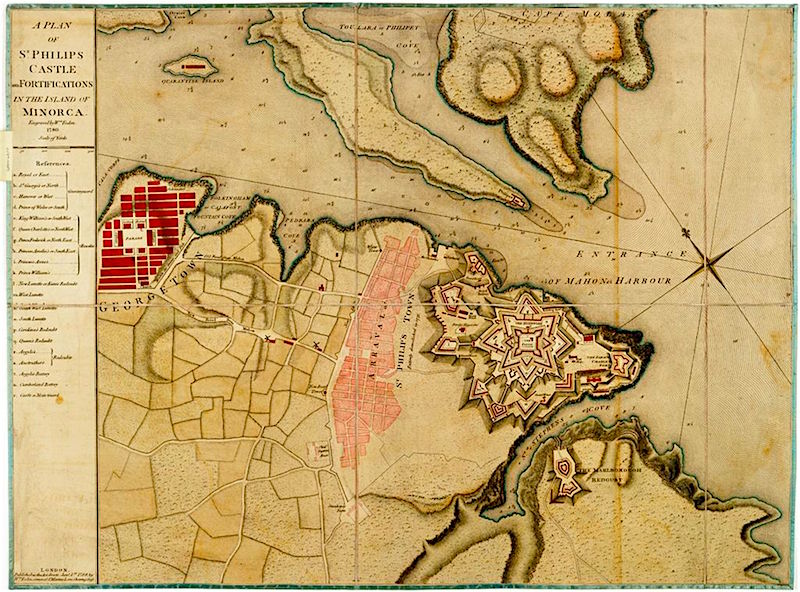
Circa 1780 plan of Fort St. Philip near Georgetown and Mahon on Minorca, courtesy of Wikipedia.
6 February, 1685
It is a curious coincidence that not just one, but TWO British monarchs have died on this day, 6 February. Most recently, as memorably depicted in the TV series The Crown, George VI died in his sleep on 6 February, 1952, and was succeeded by his 25-year-old daughter, who has reigned as Elizabeth II ever since. In the Versailles Century, Charles II also died on 6 February, in 1685. He was immediately succeeded by his closest legitimate male relation, namely his only surviving brother, the Catholic James, hitherto Duke of York. The latter was proclaimed James II of England and Ireland, and James VII of Scotland. His reign would be tempestuous and short, only 3 years and 10 months, and he would end his life a royal refugee at the court of Louis XIV, largely because of Anglican fears that he would try to re-establish the Church of Rome in England and Scotland.
Further reading: https://en.wikipedia.org/wiki/James_II_of_England
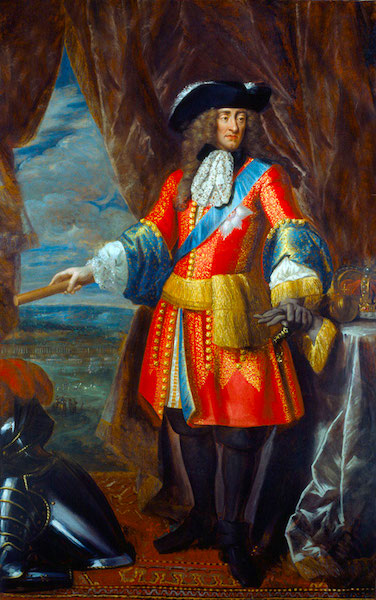
James II at around the time of his accession, courtesy of Wikipedia.
7 February, 1693
t was on this day 325 years ago that Anna Ivanovna, future Empress and Autocrat of all the Russias, was born in Moscow. She was the fourth of the 6 daughters of Tsar Ivan V (1666-1696) and his wife Praskovia Saltykova (1664-1723), but she was the second oldest of the 3 who survived to adulthood. Apart from the Orthodox religion and needlework, Anna, like all children of her caste between Moscow and Madrid, was taught French. She also learned German. Her father, Ivan V, was joint tsar with his half-brother, Peter I the Great (1672-1725), from 1682 until his death. Ivan suffered from significant mental and physical disabilities and played no part in affairs. Consequently, it was Anna’s uncle Tsar Peter who married her off to the Duke of Courland in 1710. Courland was a small, autonomous duchy in what is now Latvia Sadly, her husband died during the wedding journey from St. Petersburg back to Courland’s capital, Mitau (now Jelgava). Undeterred, Tsar Peter set Anna up as regent of the duchy, in which position she served until the death of her cousin Peter II in 1730. At that point, all the adult Romanovs were women: Elizabeth Petrovna, daughter of Peter I, Anna Ivanovna, and Anna’s 2 surviving sisters. A succession council selected Anna as Peter II’s successor. She duly set off from Courland to accept the throne of Russia. There was a challenge in store for her when she arrived in Moscow, but we’ll leave that story for another post. To make a long story short, Anna Ivanovna remained firmly seated on the throne of the tsars until her death in 1740.
Further reading: https://en.wikipedia.org/wiki/Anna_of_Russia
As far as I know, the only book-length biography of Anna Ivanovna in English is the one by Mina Curtiss, A Forgotten Empress: Anna Ivanovna and Her Era, which was published by Frederick Ungar Books in 1974.
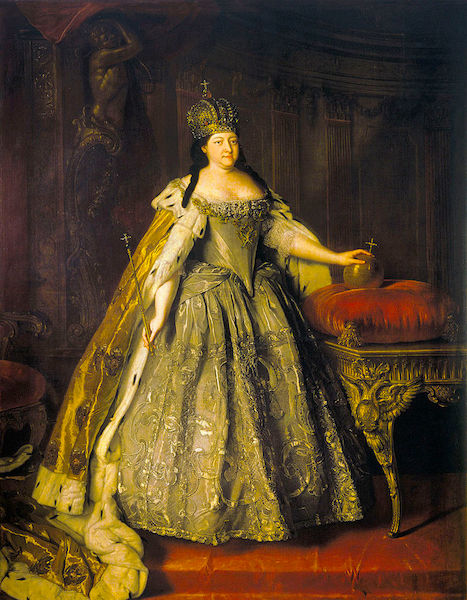
Anna Ivanovna by Louis Caravaque at the time of her accession to the Russian throne; this portrait is in the Tretyakov Museum, and I reproduce it here courtesy of WikiCommons.
8 February, 1696 and 1725
By a very curious coincidence, the only joint tsars in Russia’s history, Ivan V and Peter I, both died on an 8 February. They were half-brothers, sons of Tsar Alexis by different mothers. In 1682, there was a dispute over the succession after the death of their childless elder brother Tsar Feodor III. Ivan had significant mental and physical disabilities, while Peter, the youngest brother, was only a little boy, and the nobles feared the influence of his mother’s family, the Naryshkins. As a compromise, they were proclaimed joint sovereigns under the regency of their elder sister, the Tsarevna Sophia. Peter seized power from Sophia in 1689 and thereafter exercised power alone, although he continued formally to share sovereignty with Ivan until the latter’s death on 8 February, 1696, in Moscow. Peter the Great, as he later became known, himself died on 8 February, 1725, in St. Petersburg.
Further reading: https://en.wikipedia.org/wiki/Ivan_V_of_Russia
There are many biographies in English of Peter I the Great, but none of Ivan V, as far as I know. My favourite of the Petrine biographies is Robert K. Massie’s.
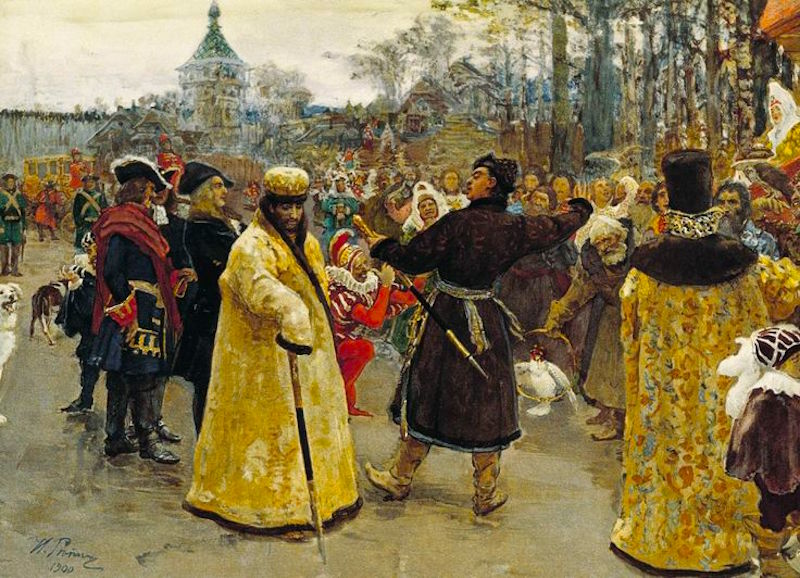
“The Arrival of the Two Tsars,” by I. Repin, courtesy of WikiCommons. Ivan and Peter are carrying gold-tipped staffs.
9 February, 1709
It was on this day 309 years ago that Louis François de Bourbon, Prince de Conti, died at the age of 45. As a handsome, charming, athletic, and brave Prince of the Blood, he ought to have had a brilliant career in the army, but an early indiscretion — he badmouthed Louis XIV in an intercepted letter — scuppered his ambitions. He didn’t improve his standing with Louis XIV when he began an adulterous affair with the Princesse de Condé, one of the King’s daughters by Mme de Montespan. Although he was devoted to her for the rest of his life, he is also known to have been passionately attached to some of his pages. Hoping to get rid of him, Louis XIV engineered his election to the Polish throne in 1697, but when he arrived in Poland he found that Augustus of Saxony had already taken possession of the crown. Louis François returned to France crown-less, but the King sufficiently warmed to him that he later appointed him to the command of an army during the War of the Spanish Succession. He died in the midst of the winter of 1709, the coldest one recorded in the last 500 years.
Further reading: https://en.wikipedia.org/wi…/François_Louis,_Prince_of_Conti
Nancy Mitford writes wittily about the Prince de Conti in a chapter of her classic book The Sun King.
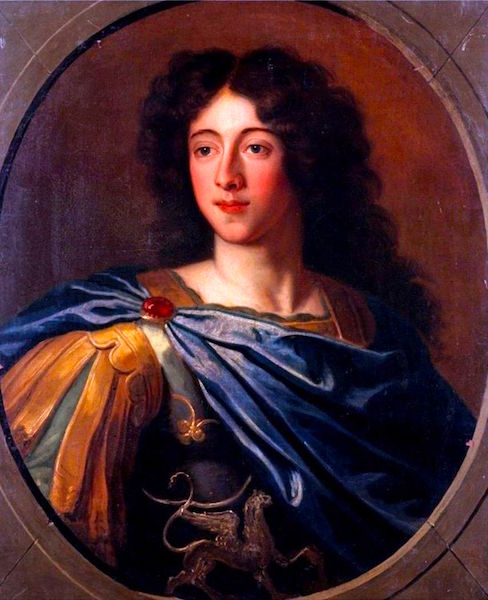
Louis François de Bourbon, Prince de Conti, painted in his youth by an anonymous artist, courtesy of Wikipedia.
I cull these events from the English, French, and German wikipedias. Occasionally, I consult wikipedias in other Romance languages and hope that I understood them correctly. Whenever possible, I suggest further reading, even it it’s only a wikipedia article. I welcome gentle correction in the comments below, on the Versailles Century Facebook page, and in the Versailles Century gallery on Instagram (@versailles_century).







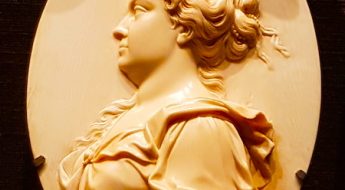
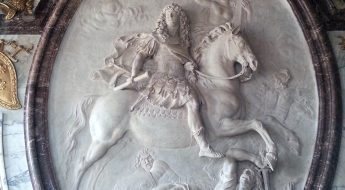








Leave a Comment